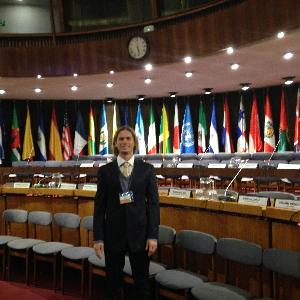Please find below the
Finalist Evaluation
Judges'' comments
Thanks for your innovative proposal. The proposal needed more information on how the social support needed to make the tool useful would be obtained.
Semi-Finalist Evaluation
Judges'' ratings
| • | Novelty: | |
| • | Feasibility: | |
| • | Impact: | |
| • | Presentation: |
Judges'' comments
Thank you for your proposal submission. For the next round of judging, please add additional detail that will help us better understand the proposal. Specifically, please describe how this is consistent - or unique from - other models available; how this will work given the need for broad collaboration and cooperation across ministries; and how the model outputs can be prioritized based on ability to implement?
We look forward to your revisions for the next round.
 Daniel Howard Jun 15, 2016 09:56 | Proposal creator Dear Climate CoLab Energy Supply contest Judges: Thank you for your time and excellent feedback. This message is intended to address your comments and has been incorporated into the ‘A global solution for decarbonizing energy systems’ proposal. The EMERGE tool was developed using a completely novel and disruptive methodology. The methodology allows for simulation of electricity grid interaction on an hourly basis, calculation of annualized economic costs, quantification and annualized monetary valuation of 18 environmental and health impacts using the latest life cycle impact assessment (LCIA) methodologies, and advanced optimization to span 10,000+ energy infrastructure scenarios. Optimization at this scale is made possible by several factors, including: utilizing country-specific reduced-form equations to calculate 18 environmental and health impacts, performing a monetary valuation of all 18 environmental and health impacts and summing all economic, environmental and health costs into a single dollar amount, and using an advanced Markov chain Monte Carlo method with Metropolis selection to very efficiently span the global parameter space that minimizes the single dollar amount. That single dollar amount is the sum of total economic, environmental and health costs. There are no known renewable energy integration models similar to EMERGE, based on reviewing the 37 renewable energy integration models in “A review of computer tools for analyzing the integration of renewable energy into various energy systems” (Connolly et al. 2012) as well as “A review of energy models” (Jebaraj et al. 2006). To quantify the uncertainty of EMERGE, an integrated methodology consisting of three industry standard models is being used. The Plexos electricity dispatch model dispatches power plants according to constraints and marginal cost, the CALPUFF dispersion model is being utilized to simulate the atmospheric dispersion of power plant emissions, and the EPA BenMAP model is being utilized to determine to map air quality changes to human health impact costs. The integrated modeling methodology only considers operational emissions, while EMERGE can be run for lifecycle or operational emissions. The health impact costs of multiple scenarios using the integrated modeling methodology will be compared to the health impact costs from the same scenarios as calculated by EMERGE to get an idea of uncertainty and the sensitivity of select modeling assumptions. EMERGE can also be run in scenario mode. This is very helpful, for example, if a country is analyzing 10 different future energy infrastructure scenarios. While the economic costs might vary by 10 – 30%, EMERGE can calculate how the environmental and health impact costs vary between scenarios, which vary greatly and can cost 10 – 100 times retail electricity prices (based on EMERGE preliminary results). The model outputs can be prioritized based on the magnitude of their cost. For example, in NE Brazil, the three impact categories of human toxicity, respiratory impacts and climate change are responsible for more than 95% of the impact costs. This implies that particulate matter impact costs, human toxicity impact costs and climate change costs should be included in energy planning analysis and decision making. Collaboration and cooperation across ministries will be very helpful to determine and implement the mix of energy sources that minimizes total economic, environmental and health costs. Policy should be set that guides the energy sector towards this lowest total cost mix of energy sources as demand increases and infrastructure depreciates. South America has been the developing region case study for this project, and the following ministries have expressed interest in EMERGE: Ecuador: Ministerio de Electricidad y Energia Renovable, Ministerio de las Sectores Estrategicos Peru: Ministerio de Energia y Minas, Ministerio de Ambiente Colombia: Unidad de Planeacio Minero Energetica, ISAGEN Chile: Comision Nacional de Energia, Centro de Energias Renovables Brazil: Conselho Nacional de Politica Energetica, Empresa de Pesquisa Energetica Uruguay: Administracion del Mercado Electrico Argentina: Secretaria de Energia Agreement among ministries in a given country will accelerate policy implementation, however it is not necessary. Ultimately, the national organization that is in charge of deciding energy infrastructure policy should be responsible for setting the mix of energy sources that minimizes total economic, environmental and health costs as a standard that the industry must meet, which can be done incrementally as capacity increases and infrastructure depreciates. Setting the mix of energy sources that minimizes total economic, environmental and health costs of electricity production will be increasingly important. Recent studies show that decarbonizing electricity grids is not enough to meet long-term GHG goals, and that transportation and industry must also be electrified, which will substantially increase electricity demand. |
 Daniel Howard Jun 15, 2016 09:27 | Proposal creator Dear Climate CoLab Energy Supply contest Judges:
Thank you for your time and excellent feedback. This message is intended to address your comments and has been incorporated into the ‘A global solution for decarbonizing energy systems’ proposal.
The EMERGE tool was developed using a completely novel and disruptive methodology. The methodology allows for simulation of electricity grid interaction on an hourly basis, calculation of annualized economic costs, quantification and annualized monetary valuation of 18 environmental and health impacts using the latest life cycle impact assessment (LCIA) methodologies, and advanced optimization to span 10,000+ energy infrastructure scenarios.
Optimization at this scale is made possible by several factors, including: utilizing country-specific reduced-form equations to calculate 18 environmental and health impacts, performing a monetary valuation of all 18 environmental and health impacts and summing all economic, environmental and health costs into a single dollar amount, and using an advanced Markov chain Monte Carlo method with Metropolis selection to very efficiently span the global parameter space that minimizes the single dollar amount. That single dollar amount is the sum of total economic, environmental and health costs.
There are no known renewable energy integration models similar to EMERGE, based on reviewing the 37 renewable energy integration models in “A review of computer tools for analyzing the integration of renewable energy into various energy systems” (Connolly et al. 2012) as well as “A review of energy models” (Jebaraj et al. 2006).
To quantify the uncertainty of EMERGE, an integrated methodology consisting of three industry standard models is being used. The Plexos electricity dispatch model dispatches power plants according to constraints and marginal cost, the CALPUFF dispersion model is being utilized to simulate the atmospheric dispersion of power plant emissions, and the EPA BenMAP model is being utilized to determine to map air quality changes to human health impact costs.
The integrated modeling methodology only considers operational emissions, while EMERGE can be run for lifecycle or operational emissions. The health impact costs of multiple scenarios using the integrated modeling methodology will be compared to the health impact costs from the same scenarios as calculated by EMERGE to get an idea of uncertainty and the sensitivity of select modeling assumptions.
EMERGE can also be run in scenario mode. This is very helpful, for example, if a country is analyzing 10 different future energy infrastructure scenarios. While the economic costs might vary by 10 – 30%, EMERGE can calculate how the environmental and health impact costs vary between scenarios, which vary greatly and can cost 10 – 100 times retail electricity prices (based on EMERGE preliminary results).
The model outputs can be prioritized based on the magnitude of their cost. For example, in NE Brazil, the three impact categories of human toxicity, respiratory impacts and climate change are responsible for more than 95% of the impact costs. This implies that particulate matter impact costs, human toxicity impact costs and climate change costs should be included in energy planning analysis and decision making.
Collaboration and cooperation across ministries will be very helpful to determine and implement the mix of energy sources that minimizes total economic, environmental and health costs. Policy should be set that guides the energy sector towards this lowest total cost mix of energy sources as demand increases and infrastructure depreciates.
South America has been the developing region case study for this project, and the following ministries have expressed interest in EMERGE:
Ecuador: Ministerio de Electricidad y Energia Renovable, Ministerio de las Sectores Estrategicos Peru: Ministerio de Energia y Minas, Ministerio de Ambiente Colombia: Unidad de Planeacio Minero Energetica, ISAGEN Chile: Comision Nacional de Energia, Centro de Energias Renovables Brazil: Conselho Nacional de Politica Energetica, Empresa de Pesquisa Energetica Uruguay: Administracion del Mercado Electrico Argentina: Secretaria de Energia Agreement among ministries in a given country will accelerate policy implementation, however it is not necessary. Ultimately, the national organization that is in charge of deciding energy infrastructure policy should be responsible for setting the mix of energy sources that minimizes total economic, environmental and health costs as a standard that the industry must meet, which can be done incrementally as capacity increases and infrastructure depreciates.
Setting the mix of energy sources that minimizes total economic, environmental and health costs of electricity production will be increasingly important. Recent studies show that decarbonizing electricity grids is not enough to meet long-term GHG goals, and that transportation and industry must also be electrified, which will substantially increase electricity demand. |
